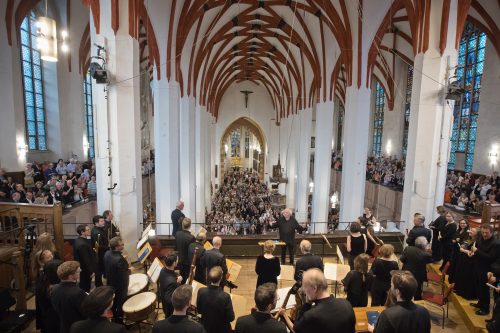 United Kingdom Bach, B minor Mass: Soloists, Collegium Vocale Gent / Philippe Herreweghe (conductor). Barbican Corridor, London, 14.6.2024. (AK)
United Kingdom Bach, B minor Mass: Soloists, Collegium Vocale Gent / Philippe Herreweghe (conductor). Barbican Corridor, London, 14.6.2024. (AK)

Dorothee Mields – soprano
Hana Blažiková – soprano
Alex Potter – countertenor
Man Reducing – tenor
Johannes Kammler – baritone
We have no idea why Bach composed this masterpiece, his B minor Mass, in direction of the top of his life. By faith Bach was Lutheran and he was within the employment of the Lutheran Thomaskirche in Leipzig (the place Collegium Vocale Gent carried out the work on 16 June) . So why to set the phrases of the Roman Catholic Mass in an in depth musical composition which, owing to its size, would have been unlikely to be carried out in any church service, not to mention within the Lutheran institution? Speculations for Bach’s motive are plentiful however, to this point, none proved. However what’s past doubt that Bach left us a grand choral-orchestral masterpiece with stunning melodies, very good polyphonic remedy, and wide-ranging musical feelings to match (or maybe even surpass) the phrases of the Mass.
The issue with Herreweghe’s in any other case admirable interpretation was the shortage of the above-mentioned wide-ranging feelings. Maybe Philippe Herreweghe was conscious of Bach’s Lutheran belonging (thus presumably favouring purity to excesses) however that is music written to phrases of the Roman Catholic Mass which isn’t afraid of feelings. Or maybe the tutorial in Herreweghe was stronger than the sense of public communication. Nevertheless, whichever means, together with his writing for the three trumpets and timpani Bach clearly implied appreciable heightened feelings.
Herreweghe performed and not using a baton and with very small arm actions. The mode and temper had been mild all through. The polyphonic strains had been clear, subdued dynamics had been fastidiously constructed, and Herreweghe’s tempi fantastically matched phrases and music. Nevertheless, for the ‘Et resurrexit’ and ‘Sanctus Dominus Deus’ choral numbers I’d have appreciated unreserved jubilation, and for the ‘Osanna in excelsis’ refrain unreserved pleasure. It must be mentioned that the ultimate refrain, ‘Dona nobis pacem’, was noble, actually expressive and radiant.
Herreweghe’s staff are skilled they usually learn their conductor properly. The 2 soprano soloists, Dorothee Mields and Hana Blažiková, set the temper fantastically with their duet in ‘Christie Eleison’: they know their music and one another properly, moreover they sang collectively in earlier Herreweghe Bach Mass performances.
The bass solos (‘Quoniam to solus Sanctus’ and ‘Et in Spiritum Sanctum’) had been sang by baritone Johannes Kammler. Like all different soloists on stage, he delivered with magnificence and professionalism. Nevertheless, he’s a baritone and I felt the shortage of a delegated bass singer in a few of the backside notes.
Tenor Man Reducing delivered each of his solos, the ‘Domine Deus’ tenor-soprano duet in addition to the Benedictus, with disciplined however decisively musical the Aristocracy.
The alto solos had been introduced by countertenor Alex Potter who gave his all all through. His solos ‘Qui sedes’, the ‘Et in unum Dominum’ alto-soprano duet and, final however not least, the ‘Agnus Dei’ solo had been stunning past description. With out breaking any baroque efficiency guidelines or affected by Herreweghe’s subdued studying Potter nonetheless managed to achieve the chic.
All Herreweghe’s singers and gamers are disciplined professionals and true staff employees. All 5 solo singers participated within the choral numbers (thus delivered by nineteen singers) and teamwork was palpable amongst instrumentalists too.
I used to be shocked to see the 2 cellists utilizing spikes for his or her devices whereas all else was pure baroque. I’d have appreciated horn soloist Bart Cypers stand extra uncovered somewhat than in the midst of the orchestra: he delivered his vital and difficult obligato solo in ‘Quoniam to solus Sanctus’ with admirable abilities however barely subdued owing to his putting throughout the orchestra.
Flute participant Patrick Beuckels mixed all the things one can want for: baroque type, clever phrasing, rhythmic changes (agogics, rubato throughout the bar) inside adhering to the construction of music and phrases, and a wide range of dynamics/ tonal colors. His obligato flute taking part in within the ‘Domine Deus’ soprano-tenor duet and, crucially, within the tenor’s ‘Benedictus’ raised the temper to a distinct degree.
The concluding choral motion ‘Dona nobis pacem’ was as stunning as significant. Politicians of the world needs to be made to take heed to it.
Agnes Kory


